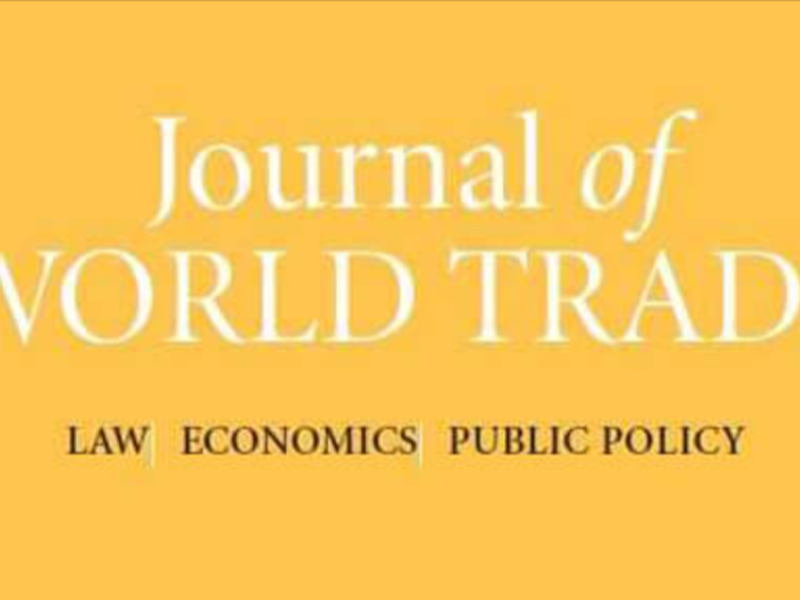Papers & Reports

Weaponization of Trade Measures and Countermeasures
This article critically examines the growing trend of weaponizing trade measures, highlighting how the expansion of national security exceptions and the rise of unilateral trade sanctions have eroded the integrity of the multilateral trading system, particularly within and beyond the WTO framework. While recent WTO cases illustrate this problem, many similar instances fall outside formal oversight, amplifying the threat to global trade stability. The article assesses the systemic risks posed by this practice and argues that, without effective safeguards, the fragile international trade order may face further destabilization. To counter this trend, the article proposes seven concrete countermeasures aimed at restoring rule-based discipline and insulating trade from geopolitical manipulation.

Capital and Income Allocation in International Tax Planning and the Coordination of Joint Innovations among Subsidiaries of MNCs
This article investigates how multinational corporations’ capital allocation decisions influence the balance between tax planning and innovation coordination across subsidiaries. Using an analytical model, it shows that while both income shifting and capital deployment can enhance tax efficiency, they can undermine joint innovation efforts across borders. Contrary to standard expectations that lower tax rates boost investment, the model predicts that tax cuts on innovative income may actually reduce innovation-related capital investment in the country enacting the cut. Empirical analysis using patent-box regimes and a stacked-cohort design supports this prediction: MNC affiliates engaged in cross-border collaboration reduce innovative activity after a rate cut, particularly in more generous or restrictive regimes. The findings underscore a key policy tension: efforts to curb income shifting through preferential innovation tax regimes may discourage coordinated investment in innovation, revealing a complex tradeoff between limiting base erosion and fostering growth through R&D.

Modernising the Permanent Establishment Concept: Evaluating Its Relevance in a Changing Business Environment and the Sufficiency of Recent Amendments
This paper examines the continued viability of the permanent establishment (PE) concept—specifically the criterion of a fixed place of business in the face of structural changes to the global economy driven by digitalisation, remote service delivery, and short-term business activity. It explores how these developments, alongside interpretive challenges with dependent agent PEs, strain the traditional PE framework. The paper argues that recent updates in the Multilateral Instrument and the 2017 OECD Model Tax Convention function mainly as anti-avoidance tools rather than comprehensive solutions. These measures provide incremental reform but fall short of fully adapting the PE concept to address remote operations and digital business models, underscoring the need for more substantive modernization of the international tax nexus rules.

Making America Great Again? The Economic Impacts of Liberation Day Tariffs
This article assesses the long-term effects of President Trump’s April 2025 “Liberation Day” tariffs and finds that while unreciprocated tariffs could modestly benefit U.S. welfare by reducing the trade deficit and offsetting income taxes, reciprocal retaliation would generate significant welfare losses. The authors derive an optimal unilateral tariff of 19%, uniform across all partners and based on the overall trade deficit—not bilateral imbalances—highlighting a major design flaw in the USTR’s approach. If trading partners retaliate optimally, U.S. welfare could fall by up to 3.8%, and global employment could shrink by 1.1%.

Canada at Trade War
This article argues that Canada must adopt a bold and multifaceted strategy to counter the existential economic and geopolitical threat posed by a second Trump administration. Faced with U.S. protectionism, populist economic nationalism, and expansionist instincts, the piece calls for Canada to move beyond traditional retaliatory tariffs and WTO complaints. Instead, it proposes a resilience-centered approach that includes diversifying trade through initiatives like a new North Atlantic Free Trade Area or even unilateral liberalization; strengthening internal commerce and transportation infrastructure; and pursuing military modernization and urban renewal. The article further advocates for using Crown Corporations and unconventional monetary tools to stabilize investment and the Canadian dollar, while reinforcing the social safety net to maintain domestic cohesion in a turbulent global trade environment.

Tariff Pass-Through in the Trade War: A Firm-Heterogeneity Perspective
This article reconciles the apparent contradiction between product-level findings of full tariff pass-through and firm-level evidence of price adjustments during the US-China trade war. Using detailed customs data, it reveals that high-priced Chinese exporters reduced their pre-tariff prices in response to U.S. tariffs, while lower-priced firms were more likely to exit the U.S. market altogether. This selective market attrition and pricing behavior results in full pass-through at the product level, even though individual firms respond heterogeneously. The analysis underscores how tariff impacts are shaped by firm-level characteristics, with market exit masking incomplete pass-through among remaining exporters.

The US-China Trade War Creates Jobs (Elsewhere)
This article analyzes the spillover effects of the US-China trade war on Brazil’s labor market and finds that Brazilian regions more exposed to China’s retaliatory tariffs against US exports experienced relative gains in formal employment and wage income, driven by increased exports to China. Conversely, US tariffs on Chinese goods had no measurable effect on Brazilian labor markets. The findings illustrate how bilateral trade conflicts can create asymmetric global labor market responses, benefiting third-party countries through redirected trade flows.

Destined for Division? US and EU Responses to the Challenge of Chinese Overcapacity
This policy brief examines the growing transatlantic divide in responses to China’s export overcapacity, particularly in sectors critical to economic growth and national security. Triggered by concerns that Chinese industrial subsidies—not comparative advantage—are driving export success, the U.S. and EU have adopted divergent strategies. While the U.S. has embraced unilateral trade measures, most dramatically under President Trump’s decision to impose a 145 percent tariff on Chinese goods, the EU continues to emphasize compliance with global trade rules. The brief explores how these differing approaches reflect broader contrasts in trade and industrial policy, and considers the potential for coordinated action. It argues that the EU is well-positioned to lead efforts within the rules-based trading system and should keep the door open for future U.S. alignment, aiming to address Chinese overcapacity through collective pressure rather than fragmentation.

The US Revenue Implications of President Trump's 2025 Tariffs
This policy briefing by the Peterson Institute for International Economics (PIIE) assesses the fiscal and macroeconomic consequences of universal U.S. tariff increases under President Donald J. Trump’s proposed trade policy. Using a global economic model, the briefing estimates that a 15 percentage point tariff on all imports could raise $3.9 trillion in federal revenue over 2025–2034 if there is no foreign retaliation, but this gain would be reduced to $3.2 trillion after accounting for negative economic impacts, and further down to $1.5 trillion if trading partners retaliate. Notably, higher tariffs do not guarantee higher revenue; a 20 percentage point increase results in only $791 billion in net gains due to amplified economic damage and retaliation. Across all scenarios, the United States would face lower GDP, investment, employment, and real wages, alongside higher short-term inflation. Sectors most exposed to export markets—agriculture, mining, and manufacturing—would bear the brunt, especially if foreign retaliation targets U.S. exports. The briefing underscores the trade-off between revenue generation and economic harm, warning that broad-based tariffs risk undermining long-term economic health even as they increase government receipts.

Killing the WTO
This article argues that the WTO has become irreparably dysfunctional and should be retired as a multilateral institution. Once hailed as a superior successor to GATT with its Appellate Body celebrated as an antifragile mechanism for resolving trade disputes, the WTO has failed to adapt its rules to modern economic realities and has become increasingly ineffective at enforcing its own legal framework, particularly in the face of growing reliance on national security exceptions and the collapse of its adjudicative functions. Applying Taleb’s concept of antifragility, the article contends that the WTO no longer strengthens under stress but instead has become fragile and inert, unable to innovate or govern the evolving global trade environment. It concludes that the WTO's institutional decline is beyond reform, and that the international community should move toward new structures better equipped to serve the demands of contemporary global trade.


































